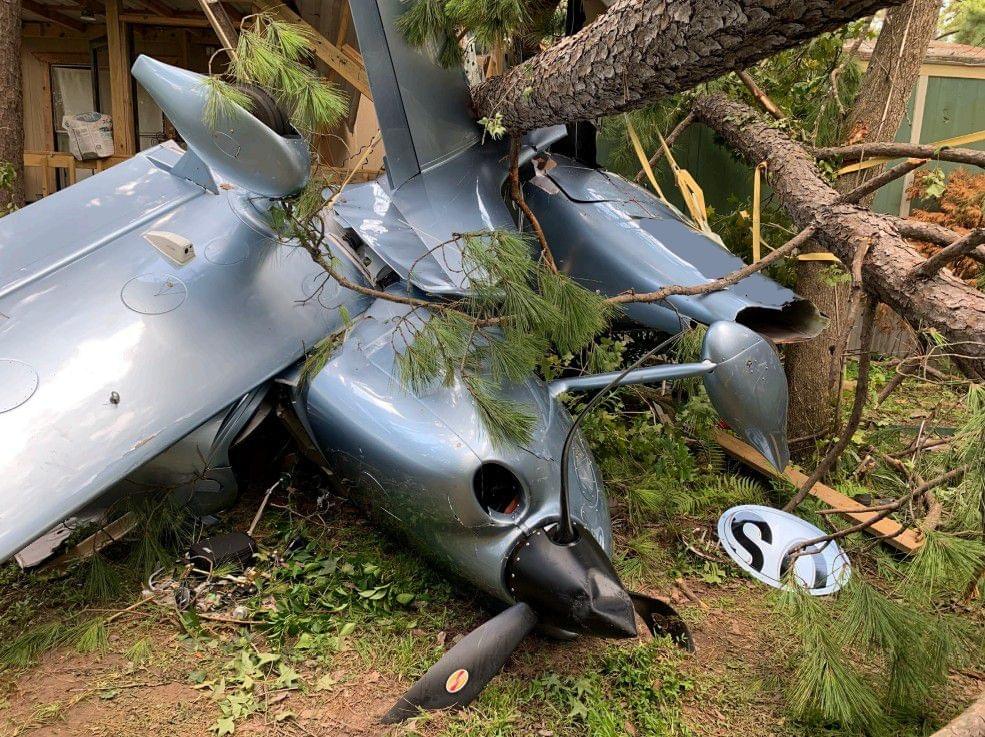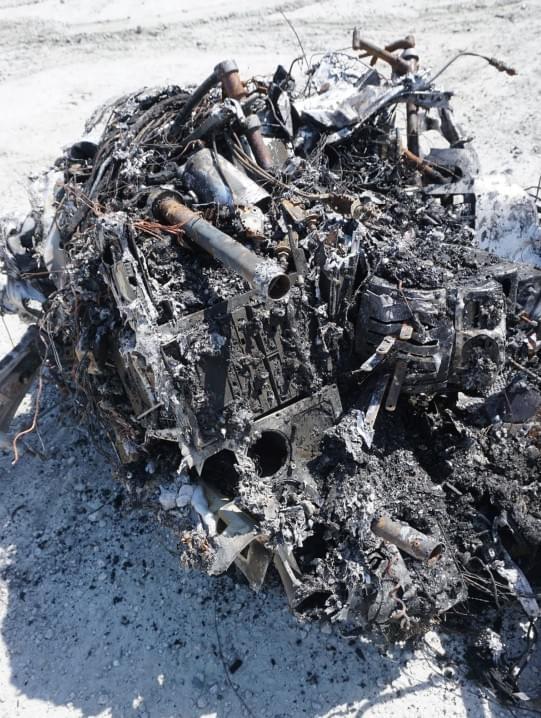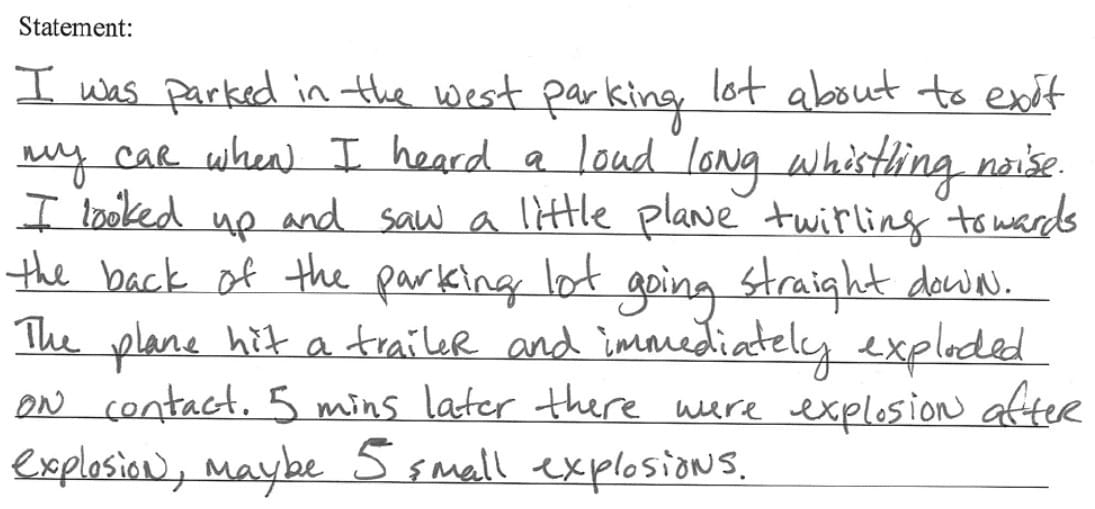
Another New Edition of "Old Pilot Tips" is Available
Episode #33 in our series offers a 2-step plan for avoiding dehydration on long flights. This shorts video is just 44 seconds long. The video is sponsored by @Avemco and is narrated by Gene Benson. Click here to check out "Sneaky Danger of Dehydration."
Superb Issue of the FAA Safety Briefing
If you have not seen the latest issue of "FAA Safety Briefing" be sure to check it out. In my opinion, this is the best issue so far. Click here to check it out.
Aircraft Tires
I have noticed an uptick in incidents and accidents related to airplane tires over the past six months or so. We don't always give our tires the care and respect they deserve. They often just receive a quick glance during the preflight inspection and even that is difficult if the airplane has wheel pants installed. Regardless of what brand of tires you use, I recommend downloading and reading a Care and Service Manual from Michelin Aircraft Tires. Some information is specific to their tires, but much applies to all aircraft tires. Click here to download the document from the Vectors website.
Recommended Video
We are in the midst of thunderstorm season in North America. Thunderstorms are leading cause of dangerous windshear. Click here to check out our nine-minute "Low-Level Windshear Essentials" video on YouTube.
Save the Date
The Syracuse Safety Stand Down which was originally scheduled for March 2025 has now been rescheduled for Saturday, September 6, 2025. I will be there for the entire day and will be doing one presentation. Stop by and say Hi!. Details will be coming soon. Check FAASafety.gov after the middle of August.

Inductive Reasoning
Inductive reasoning is not a skill but rather a complex process incorporating many of the skills previously discussed. It is a form of reasoning that takes specific knowledge, through observation and experience, and then creates a general conclusion. It relies heavily on memory based on previously learned information and experience. The conclusion drawn is not always completely accurate due to incorrectly learned or remembered information, or lack of awareness of some variables.
Inductive reasoning ability is critical for pilots in aeronautical decision making (ADM). Flight planning requires consideration of existing and forecast weather, aircraft performance, fuel planning, interpretation of aeronautical charts, pilot fitness-for-duty, and much more. During flight pilots must use inductive reasoning to continually monitor the flight for changing conditions, whether they be environmental, aircraft performance, or unanticipated abnormal operation of the airplane.
Certain medical conditions may affect the frontal lobe and therefore the pilot’s ability to use inductive reasoning. Some mental health issues may affect how an individual will use inductive reasoning. Medical conditions that affect the frontal lobe include: Alzheimer's disease and other neurodegenerative disorders.
Improve Inductive Reasoning
Inductive reasoning skills can be improved by completing logic puzzles, exercises and brainteasers. Using deductive skills in hypothetical scenarios, can improve the ability to apply them in real situations.
Click here to download the free "Aging Pilot Report."

A Capabilities Thief
We have all seen the graph that plots pilot capabilities vs. task load showing the safety margin as the distance between the curves. The capabilities of a pilot at any given moment are dependent on many factors including training, experience (overall and recent) familiarity with the airplane, pilot health, fatigue, stress, medications, and more. One insidious thief of pilot capabilities is dehydration.

Extensive research consistently reveals that even mild dehydration, characterized by a body mass reduction of as little as 1-2%, leads to measurable declines in critical cognitive abilities. This includes a notable deterioration in attention, memory, and executive function, alongside a distinct impairment in decision-making accuracy and a significant slowing of reaction times. These effects are not merely subjective; they are quantifiable and negatively reduce a pilot’s capabilities.
Dehydration occurs when the body's fluid intake falls short of its fluid loss, resulting in an insufficient supply of water and other essential fluids necessary for the body's normal operations. This imbalance can arise from various factors. Simple reasons often include inadequate fluid consumption, such as when a pilot restricts fluid intake to extend “bladder range.”
The adverse effects of dehydration on cognitive performance are produced by the complex interaction of physiological mechanisms that directly compromise brain function. Dehydration reduces blood volume, decreasing blood flow to the brain. A direct consequence is a diminished delivery of oxygen and essential nutrients to brain tissue. Electrolytes, such as potassium, sodium, and calcium, facilitate the transmission of electrical signals between cells and for proper muscle contraction. Dehydration can significantly disrupt this delicate electrolyte balance. When electrolytes are out of equilibrium, the electrical signals they transmit can become mixed or impaired, and result in slower reaction times.
Of all the things that can reduce pilot capabilities, thwarting this “capabilities thief” is among the easiest to accomplish. Simply drinking enough water solves the problem, but the sensation of thirst is not a reliable indicator of the need for water. Pilots should “hydrate up” beginning a few hours before a flight and make sure to take water along to maintain good hydration during the flight.
Pure water is ideal for hydration. Sports drinks are only needed after intense perspiration, but often contain extra sugar and preservatives. Avoid highly caffeinated energy drinks as they can worsen dehydration. A cup or two of coffee won't cause dehydration but shouldn't count toward your fluid intake.
Finally, let’s not allow our solution to one problem to cause another one. We must be mindful of our own “bladder range.” A full bladder can adversely influence our decision making. More than one pilot has decided to continue a bad approach in favor of a more expeditious arrival at a restroom. There are some strategies and hardware available for bladder relief in flight, but they sometimes have their own issues. Planning a stop along the way is generally a better solution. Think of it as contributing to proficiency by adding an extra approach, landing, and takeoff. We might even have an opportunity to socialize with a few other pilots.

Accidents discussed in this section are presented in the hope that pilots can learn from the misfortune of others and perhaps avoid an accident. It is easy to read an accident report and dismiss the cause as carelessness or as a dumb mistake. But let's remember that the accident pilot did not get up in the morning and say, "Gee, I think I'll go have an accident today." Nearly all pilots believe that they are safe. Honest introspection frequently reveals that on some occasion, we might have traveled down that same accident path.
We don't expect airplanes to crash when there is an instructor on board, especially when it is a brand-new airplane and the CFI is a factory instructor employed by the aircraft manufacturer. Yet, we see one here and it just might relate to this month's blog.
The crash involved a new Cirrus SR22, and it happened in Texas in September 2022. The pilot receiving instruction and a rear seat passenger survived the crash with serious injuries, but the flight instructor died in the crash. The NTSB accident report begins: "The pilot was in the process of receiving transition flight training after he accepted delivery of his factory-new airplane earlier in the week. On the morning of the accident, the pilot told his factory flight instructor that he did not feel well, and the decision was made to fly crosscountry to the pilot’s homebase instead of continuing his transition training at the delivery center."

Photo Source: NTSB
The NTSB report continues, "The flight approached the intended destination when about 1 minute before the accident, about 988 ft above ground level (agl) and 2.26 nautical miles (nm) from the runway displaced threshold, there was a total loss of fuel flow and subsequent loss of engine power. About 15 seconds later, 860 ft agl and 1.8 nm from the displaced threshold, the automatic flight control system (AFCS) was turned off and remained off for the remainder of the flight. With the AFCS disengaged, the flight crew continued the descent toward the runway under manual flight control and in visual meteorological conditions.
The position of the power (throttle) lever and mixture control were not recorded parameters. However, based on recorded manifold pressure indications, the throttle was decreased once and then increased twice after the total loss of engine power. The first, partial, increase of throttle occurred about 31 seconds after the loss of engine power as the airplane descended through 602 ft agl about 1.49 nm from the runway displaced threshold. This first throttle increase was likely when the pilot attempted to increase engine power to increase the airplane’s airspeed at his flight instructor’s request. The second throttle increase, likely to the full throttle position, occurred about 42 seconds after the loss of engine power as the airplane descended through 407 ft agl about 1.23 nm from the runway displaced threshold. The airplane impacted trees and terrain about 20 seconds after the second throttle increase and came to rest in a wooded mobile home neighborhood."

Photo Source: NTSB
The NTSB report continues further: "The second throttle increase likely was when the flight instructor became aware of the loss of engine power and assumed control of the airplane from the pilot. However, when the flight instructor advanced the throttle to full forward, the airplane was at least 200 ft below the minimum altitude threshold (600 ft agl) for a normal Cirrus Airframe Parachute System (CAPS) deployment. CAPS training documentation and pilot operating handbook (POH) guidance recommend the immediate deployment of CAPS if no other survivable alternative exists. At no point after the total loss of engine power did the airplane have sufficient altitude to glide to the runway.
Based on recorded data, there was ample fuel in both fuel tanks at the time of the accident. A postaccident examination revealed no evidence of obstructions or debris in the fuel system. The 90° elbow inlet fitting to the electric fuel pump was found separated at the accident site. Based on a laboratory analysis, the 90° elbow inlet fitting separated during ground impact and, as such, did not contribute to the sudden loss of fuel flow to the engine. Examination of the engine and related systems did not reveal any mechanical malfunctions or failures that would have precluded its normal operation."

Photo Source: NTSB
This paragraph from the NTSB report shows a possible tie-in with this month's blog: "The flight instructor was likely in physiological distress during the flight, which distracted him from maintaining situational awareness as the flight approached the destination. According to the pilot and the passenger, shortly after departing on the accident flight, the flight instructor stated that he had to urinate. It was the pilot’s perception that the flight instructor was in discomfort during the latter stages of their flight for this reason. Being under any sort of physiological stress would have diminished the flight instructor’s ability to perceive the environment around him and would have diverted his attention away from the task at hand. Divided or diverted attention makes it difficult to detect and correctly interpret stimuli, which in turn affects the decision-making process. Additionally, distraction can prevent a person from either identifying or properly attending to important information."

Photo Source: NTSB
And also included in the NTSB report, "The pilot was inexperienced in the airplane and was operating under the assumption that the flight instructor was the one who was ultimately responsible for the flight, thereby shedding some of the heightened level of awareness typically required to safely fly the airplane. The pilot was also not feeling well (he was diagnosed with COVID-19 after the accident), which was the primary reason that they were returning to his homebase and not continuing his training at the delivery center. Numerous studies have been conducted on how being sick might affect cognitive performance, and how fatigue (a common side effect of being sick) affects performance. Researchers liken both to a level of impairment similar to what one might expect from being intoxicated. Common results are loss of memory, inattention, lack of alertness, and poor judgment and decision-making."
The NTSB report also includes other relevant information such as that the pilot was not aware of the loss of engine power and that both the CFI and pilot were using noise cancelling headsets. It speculates that both pilots were highly likely to be susceptible to continuation bias and that the cues regarding engine poser loss might have gone unnoticed. Significantly, the pilots had not discussed roles regarding who was in command or who would perform what duties in the event of an emergency.

Photo Source: NTSB
The NTSB probable Cause Findings states: "The flight instructor’s inadequate supervision of the flight, which allowed for an unintentional movement of the mixture control to the cutoff position that remained unnoticed until the airplane lost engine power due to fuel starvation and descended below the minimum altitude required for a normal deployment of the airframe parachute system. Contributing to the accident was the impairment of the pilot due to his illness, the flight instructor being distracted by his physiological distress, and the apparent lack of communication between the pilot and flight instructor about who was responsible for the safety of the flight, all of which created a situation where neither individual was adequately monitoring the engine operation during a critical phase of flight."
Unfortunate events such as this provide us with lessons to be learned (or relearned). Whenever two pilots occupy control positions in the same aircraft, communication regarding who is pilot-in-command and what roles and responsibilities will be expected of each pilot. Next, it is not a good idea to occupy a control position with any expectation of participating in the flight as a pilot when ill. It was determined that the pilot's illness was a result of the COVID-19 virus. Finally, relating to this month's blog, the CFI had physiological discomfort throughout the flight due to a need to urinate. That can be extremely uncomfortable and distracting. Landing at an airport along the way would have taken extra time and extra fuel but just might have allowed for more mental clarity and awareness of the loss of engine power.
Click here to download the accident report from the NTSB website.

Accidents discussed in this section are presented in the hope that pilots can learn from the misfortune of others and perhaps avoid an accident. It is easy to read an accident report and dismiss the cause as carelessness or as a dumb mistake. But let's remember that the accident pilot did not get up in the morning and say, "Gee, I think I'll go have an accident today." Nearly all pilots believe that they are safe. Honest introspection frequently reveals that on some occasion, we might have traveled down that same accident path.
This crash does not relate to this month's blog theme of dehydration, but it does emphasize the importance of following regulations and recommended procedures. That includes being fit-to-fly and following the IM SAFE checklist. Though seemingly obvious, having an airworthy airplane is necessary. It also dramatically illustrates the importance of using all available passenger and pilot restraints.
The crash happened during landing in Arkansas in October 2021 and involved a Cessna 150L. The 71-year-old private pilot with 170 hours estimated flight time received fatal injuries after being ejected from the airplane during the crash sequence. The passenger, secured by the installed 3-pioint restraint, received minor injuries.

NTSB Photo
The NTSB report includes the following: "According to the passenger, the airplane started to veer to the left once the pilot lowered the nosewheel onto the runway. The pilot asked the passenger if he was on the rudder pedals and the passenger responded that he was not. The pilot then stated that he could not slow the airplane down. The airplane veered off the left side of the runway into the grass and impacted a chain link fence that was parallel to the runway. The pilot was not wearing his seat restraints. He was ejected from the airplane and sustained fatal injuries." The report continues, "The airplane sustained substantial damage to both wings. Examinations of the airplane’s flight controls, and brake assemblies did not reveal any pre-impact anomalies."

Graphic Source: Google Earth - Forest City Muni Airport
The NTSB report also includes the following: "Postaccident examination of the airplane revealed that the airplane was in poor mechanical condition. The aft elevator bellcrank was severely corroded and the bearing exhibited a rough or ratchet-type movement. An insect nest was observed inside the separated aileron piece. The rudder stop-bolts and associated hardware appeared to be the original size and were severely corroded. The elevator trim actuator chain remained engaged on the actuator sprocket. The chain appeared dry and corroded. There did not appear to be fresh grease on any chains, pulleys, or hinges. The airplane paint was faded and peeling. Bird feces covered the airframe and engine, and insect nests were found in the cabin, wings, and tail cone. All exposed hardware on the airplane was severely corroded. Neither the pilot logbooks nor the airplane maintenance records were available for review during the investigation. The pilot’s most recent FAA medical examination was on February 17, 1993. At that time, the pilot reported civil flight experience of 130 total hours."
The analysis section of the NTSB report states: "The pilot’s toxicology results indicate that he had used diphenhydramine and might have experienced some impairing cognitive effects from it at the time of the accident. Diphenhydramine’s potential for postmortem redistribution complicates more precise interpretation of the drug’s concentration in heart blood, although it is unlikely that the pilot followed Federal Aviation Administration (FAA) guidance to wait 60 hours after using the drug before flying. The pilot’s lack of medical certification, the unairworthy condition of his airplane, and his decision not to wear his restraints indicate a chronic pattern of tolerating unsafe levels of risk. His diphenhydramine use might be a manifestation of that pattern, but it could not be determined if it significantly contributed to the accident."

NTSB Photo
The NTSB probable cause states: "The pilot’s loss of control during landing. Contributing to the pilot’s injuries was his ejection from the airplane resulting from him not wearing his available seat restraints."
In addition to the obvious lessons regarding following rules and procedures, the highly impairing effects of diphenhydramine cannot be overstated. Its presence in many OTC medications for the treatment of symptoms caused by allergies, the common cold, and sleep disorders makes it easy to unintentionally ingest it. Before taking any OTC medication, it is important to check the ingredients. There are effective alternate medications available that do not contain diphenhydramine. Pharmacists are excellent resources in helping to steer clear of impairing substances. The FAA and NTSB have strongly stated the impairing effects of diphenhydramine and recommend a 60-hour gap between the last dose and first flight. Let's take that one step further and ask ourselves about driving a vehicle or engaging in other critical activities. Is the impairment from diphenhydramine limited to flying an airplane? Probably not.
Click here to download the accident report from the NTSB website.

Accidents discussed in this section are presented in the hope that pilots can learn from the misfortune of others and perhaps avoid an accident. It is easy to read an accident report and dismiss the cause as carelessness or as a dumb mistake. But let's remember that the accident pilot did not get up in the morning and say, "Gee, I think I'll go have an accident today." Nearly all pilots believe that they are safe. Honest introspection frequently reveals that on some occasion, we might have traveled down that same accident path.

Accident Airplane N84GR Before and After the Crash
This crash does not relate to this month's theme, but it certainly worthy of discussion. The official reports raise more questions than answers. We will look at the published information and then try to dive a bit deeper.
From the NTSB report: "The crash happened in Georgia in April 2022. The airplane was a Cessna 340. The NTSB accident report begins as follows: The student pilot, who was the new owner of the multi-engine airplane, and a private pilot flew commercially to Lubbock, Texas, utilized a ride-hailing service to drive to Portales, New Mexico; they met with the former owner of the airplane to finalize the purchase of the airplane and flew it back to Georgia the same day. The next day, the student pilot commenced flight training with the private pilot who offered to provide flight instruction to the student pilot in the student pilot’s newly acquired multi-engine airplane, even though he did not possess a flight instructor’s rating or a multi-engine airplane rating."
And the report continues: "The postaccident examination of the airframe, engines, and propellers revealed no anomalies that would preclude normal engine and airplane performance. Additionally, a review of the maintenance logbook revealed that the airplane was overdue for its annual maintenance inspection; no special flight permit (ferry permit) was obtained from the Federal Aviation Administration (FAA) for its return flight to Georgia."
What could possibly go wrong here? Read on as we see the continuation of the slippery slope of non-compliance.

NTSB Photo
"Toxicological testing of the student pilot revealed the presence amphetamine, a prescription Schedule II controlled substance that may result in cognitive deficits that pose a risk to aviation safety; however, its effect, if any on the accident flight could not be determined. It is likely that the private pilot’s failure to maintain aircraft control was exacerbated by his lack of a multi-engine airplane rating, his lack of a flight instructor rating, and his poor decision making."

NTSB Graphic
The NTSB probable cause states: "The private pilot’s loss of control in flight, which resulted in a collision with terrain. Contributing to the accident was the student pilot’s decision to obtain flight instruction from the private pilot and the private pilot's insufficient qualifications to fly or to provide flight instruction in a multi-engine airplane."

NTSB Photo
The NTSB docket continues a document (shown below) referencing a statement made by the previous owner of the airplane. It indicates that the new owner, the student pilot, was aware of the airplane not being in compliance with annual inspection regulations.

Source: NTSB
The crash was catastrophic as it set off several explosions and a large fire in an industrial area. Miraculously, no people on the ground were injured. The accident report indicates that it could not be determined which pilot seat the occupants occupied and that the student pilot was identified by dental records and the private pilot by DNA. A statement from a crash witness is shown below.

Source: NTSB
As stated in the beginning, this crash raises many questions not answered by the official documents. Was the student pilot aware that the pilot he engaged to teach him to fly the airplane was neither multiengine rated nor a flight instructor? Did the student pilot plan to do all his training in this very complex multiengine airplane? Why would a private pilot so flagrantly violate regulations (and common sense) to offer or agree to teach a student pilot, apparently with zero flight time, how to fly an airplane that he himself was not rated to fly? We do not have answers to these questions, but we do have a lesson. Color between the lines. Follow regulations and recommended practices. Do not take that slippery slope of non-compliance. The is often a bad landing at the end of the slope.
Click here to download the accident report from the NTSB website.
Not subscribed to Vectors for Safety yet? Click here to subscribe for free!
